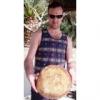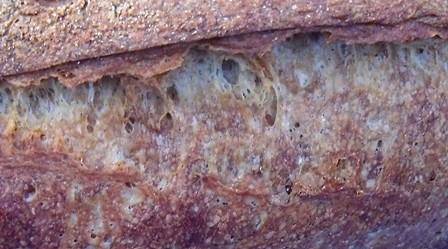This is the second bread from this weekend's bake that is from the late Bernard Clayton Jr.'s New Complete Book of Breads, as both an expression of gratitude and a memorial of sorts.
Mr. Clayton's Pain Seigle is one that I have not previously made. It is an interesting bread, from the standpoint that approximately 50% of the flour is in two preferments: a "starter" made with commercial yeast and a sponge. It also has a high rye content, with 2 cups bread flour to approximately 5 cups of rye flour.
Starter
1 cup rye flour [I used the only rye flour available to me, a finely milled whole rye]
1 teaspoon dry yeast
1 cup warm water (105º-115º)
Mr. Clayton recommends a fermentation period in a covered bowl running from a minimum of 6 hours up to 36 hours. I let mine ferment from Friday evening to Saturday evening, about 26 hours.
Sponge
All of the starter
1-1/4 cups warm water (105º-115º)
1 cup bread or all purpose flour
1-1/2 cups rye flour
Blend the water with the starter, then blend in the flours. Cover and allow to ferment 8 hours or more. I let this ferment overnight, then mixed the final dough around 11:30 Sunday morning, a total of 14 hours. The sponge ballooned, at least quadrupling its original volume. Plan accordingly.
Final Dough
All of the sponge
1/2 cup hot water (120º-130º)
1 tablespoon salt
2-1/2 cups rye flour, approximately
1 cup bread or all purpose flour
Stir the hot water and salt into the sponge, then add 1 cup of each flour. Mr. Clayton's instructions say to mix by hand or machine for 15 minutes, adding the remaining rye flour until the dough is a shaggy mass that can be kneaded. Here's where I took a slightly different path. Mr. Clayton's descriptions and directions, while acknowledging that the dough will be sticky enough to warrant kneading with a bench knife or bowl scraper, still reflect a wheat-flour-based mindset. Kneading, if by hand, should be done on a floured surface; "it will gradually lose its stickiness and become soft and elastic." With all due respect, no. I found that the white flour in the sponge had developed a very strong gluten network from its overnight hydration. Adding the last cup of bread flour increased that. However, the more rye flour that was added, the more this became a rye dough insofar as its handling characteristics went. Being mindful of rye's fragility, I did about 3 minutes of stretch and folds in the bowl (as opposed to 5 minutes of kneading), then turned the dough out onto a wet countertop so that I could shape it into a rough ball. That also let me clean and oil the bowl for the next fermentation which, per instructions, was timed at 40 minutes. No indications were given for the dough's expansion or appearance at the end of this bulk fermentation, so I watched the clock.
Mr. Clayton instructs to "punch down the dough" and "knead for a minute or two to press out the bubbles." I didn't see a significant change in the dough at the end of 40 minutes, certainly nothing to warrant punching down or kneading. Clayton recommends forming into 3 boules of about 1 pound each. I elected to form 2 boules. This was followed, per instructions, by a 30-minute final ferment on the baking sheet.
Glaze
1 egg yolk
1 tablespoon milk
The egg yolk and milk are blended together and brushed on the loaves. Mr. Clayton recommends glazing before slashing.
The bread is baked in a 400º dry oven for about 45 minutes, until a finger thump on the bottom crust produces a hollow sound.
Here's how it looked:

And a somewhat closer view:

It is a handsome bread. The glaze imparts a lovely sheen. It is also obviously underproofed. My kitchen temperature today was in the low 70's, perhaps not as warm as Mr. Clayton's "room temperature."
As noted in a previous post, my cup of flour probably weighs less than Mr. Clayton's cup of flour. Therefore, it is likely that these are somewhat higher than his in hydration. Now that I have this bake as a baseline, I would probably extend the bulk ferment and the final ferment to a point that I could see more obvious indications of inflation in the dough. These may be somewhat dense and tight-grained when I get around to cutting into them. That won't be until later this week, since they will go into the freezer once they have cooled thoroughly. They don't feel like bricks, so I will keep my fingers crossed. I can't remember whether I've made an unseeded rye before, so I'm looking forward to seeing how the rye tastes all on its own.
Paul

























